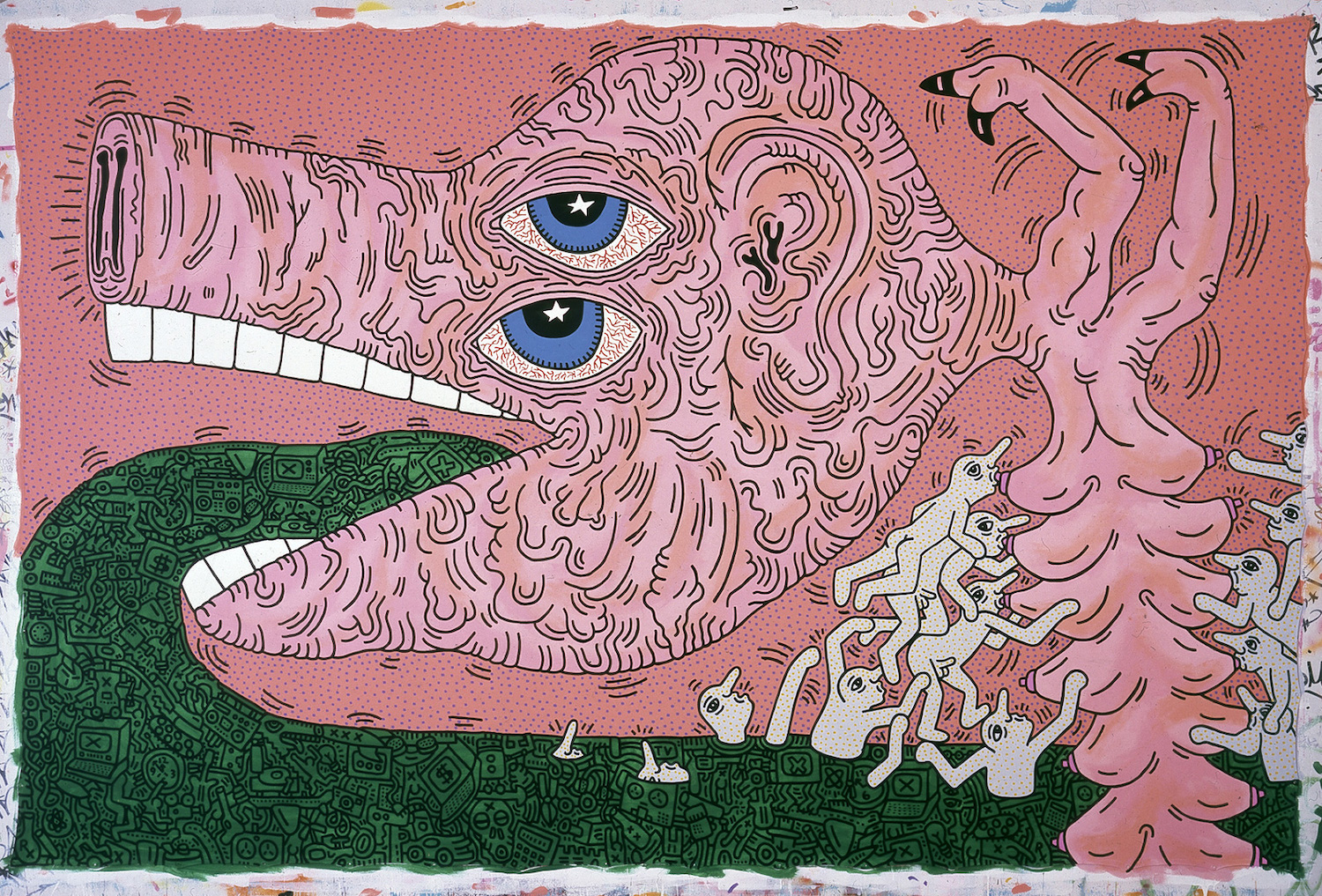In this age of AI and NFTs, the art of the ’80s can seem downright antique. Media darlings of the day — Julian Schnabel, David Salle, Eric Fischl — are now museumified, figures of art history. But as with anything we humans do, when it comes to art, looking back is as important as looking forward. In 2017, the Whitney Museum did just that with “Fast Forward: Painting from the 1980s.” Now, with “Keith Haring: Art is For Everybody,” The Broad in Los Angeles does a deep dive into the work of one of the most broadly popular artists of the decade.
Haring made art and art-making seem like fun. He was ambitious, but his drive wasn’t the go-getting “greed is good” kind typified by the 1987 movie Wall Street. Sure, he went commercial with Pop Shop, a retail venue filled with product bearing his signature imagery, but he also created dozens of public works in support of various charities. His early style, characterized by simple figures ever in motion — a crawling baby, a barking dog, a flying saucer — was often purely playful, but in time, his repertoire expanded to express a joyful homoeroticism, as well as to agitate for change.
“He made work in resistance to the conservative movement sweeping the nation during the Reagan era — work that was critical of capitalism, that responded to racism both in the U.S .and abroad, and that was critical of the nuclear arms race of the Cold War era,” notes curator Sarah Loyer. “He also used Christian iconography subversively to speak out against the dominant moral code of the time, when the Christian right was lobbying against safe sex education and held a firm anti-gay stance despite the growing AIDS epidemic.” (Haring died of AIDS-related complications at age 31 in 1990.)
Hugh Holland’s “Locals Only” Captures the Wild, Carefree Spirit of ’70s Skate Culture
Nothing looks quite as free as Southern California a half-century agoRaised in Kutztown, Pennsylvania, Haring studied briefly at a commercial arts school after graduating high school, but realized right away he was after something else and headed to New York where he enrolled at the School of Visual Arts. Immersed in the downtown scene, he flourished. He reveled in the energy of the streets and dance clubs and exercised his mind, with reading that ranged from the essays of Ashcan School artist Robert Henri, to the transgressive texts of William S. Burroughs. Like most everyone else, he couldn’t escape the anything-goes ethos of Andy Warhol, but was also influenced by the more sober, public-engaging aspect of Christo and Jeanne-Claude’s large-scale environmental installations.
Where Jean-Michel Basquiat’s work was often disquieting and Kenny Scharf’s Chicago Imagist-meets-Dr. Seuss oeuvre could be just plain goofy, Haring’s occupied a middle ground. Simple and glyph-like, it was immediate and accessible, even when he went for a dense, all-over pattern, filling a canvas or sheet of paper from edge to edge.
As his career grew, he began by making chalk drawings on blank advertising panels in the subway and went on to be included in such high-profile art world events as Documenta 7 in Kassel, the São Paulo Biennial and the Whitney Biennial. Haring never veered from a determination to make art that spoke to people, even after his death. In an interview with Daniel Drenger that appeared in the Columbia Art Review in 1988, Haring — already public about his illness — mused, “All of the things that you make are a kind of quest for immortality. Because you’re making these things that you know have a different kind of life. They don’t depend on breathing, so they’ll last longer than any of us will.”
“Remarkably, he accomplished what he set out to do,” Loyer says. “His imagery continues to saturate popular culture today. Even if someone doesn’t know his name, if you show them a picture of his imagery, they’ll likely recognize it. Haring has had a massive impact on pop culture, and this show is meant to provide a deeper look at the scope and complexity of his practice.”
“Keith Haring: Art is For Everybody” runs from May 27 to October 8
This article was featured in the InsideHook LA newsletter. Sign up now for more from the Southland.
